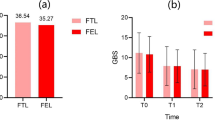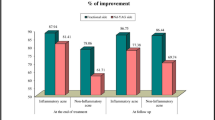Abstract
We evaluated the short-term and long-term effects of the 1550 nm erbium:glass (Er:glass) fractional laser in the treatment of facial acne vulgaris. Forty-five (9 male and 36 female) acne patients were treated 4 times at 4-week intervals with the following parameters: 169 spot density and 15–30 mJ/cm2 fluence. There was no control group. The laser spots were adjustable (maximum overlap: 20 %) according to the treatment area, and delivered in rows in order to cover all the face. Clinical photographs were taken. The IGA scores and lesion counts were performed for each treatment. Their current state was obtained by phone call follow-up to determine the long-term effect and photographs were offered by themselves or taken in hospital. After four treatments, all patients had an obvious reduction of lesion counts and IGA score and the peak lesion counts decreased to 67.7 % after the initial four treatment sessions. For long-term effect, 8 patients lost follow-up, hence 37 patients were followed-up. 8 patients were 2-year follow up, 27 at the 1-year follow-up, and all patients at the half-year follow-up. The mean percent reduction was 72 % at the half-year follow-up, 79 % at the 1-year follow-up and 75 % at the 2-year follow-up. Side effects and complications were limited to transient erythema and edema, and few patients suffered from transient acne flare-ups and sensitivity. All patients responded that their skin was less prone to oiliness. In conclusion, acne can be successfully treated by 1550 nm Er:glass fractional laser, with few side effects and prolonged acne clearing.






Similar content being viewed by others
References
Kraning KK, Odland GF (1979) Prevalence, morbidity, and cost of dermatological diseases. J Invest Dermatol 73:395–401
Friedman PM, Jih MH, Kimyai-Asadi A, Goldberg LH (2004) Treatment of inflammatory facial acne vulgaris with the 1450 nm diode laser: a pilot study. Dermatol Surg 30:147–151
Williams HC, Dellavalle RP, Garner S (2012) Acne vulgaris. Lancet 379(9813):361–372
Davidovici BB, Wolf R (2010) The role of diet in acne: facts and controversies. Clin Dermatol 28(1):12–16
Bernstein EF (2007) A pilot investigation comparing low-energy, double pass 1,450 nm laser treatment of acne to conventional single-pass, high-energy treatment. Lasers Surg Med 39(2):193–198
Bogle MA, Dover JS, Arndt KA, Mordon S (2007) Evaluation of the 1,540-nm erbium: glass laser in the treatment of inflammatory facial acne. Dermatol Surg 33(7):810–817
Narurkar VA (2009) Nonablative fractional laser resurfacing. Dermatol Clin 27(4):473–478
Kim HJ, Kim TG, Kwon YS, Park JM, Lee JH (2009) Comparison of a 1550 nm erbium:glass fractional laser and a chemical reconstruction of skin scars (CROSS) method in the treatment of acne scars: a simultaneous split-face trial. Lasers Surg Med 41(8):545–549
Angel S, Boineau D, Dahan S, Mordon S (2006) Treatment of active acne with an Er: glass (1.54 microm) laser: a 2-year follow-up study. J Cosmet Laser Ther 8(4):171–176
Charakida A, Charakida M, Chu AC (2007) Double-blind, randomized, placebo-controlled study of a lotion containing triethyl citrate and ethyl linoleate in the treatment of acne vulgaris. Br J Dermatol 157(3):569–574
US Department of Health and Human Services. Food and Drug Administration. Center for Drug Evaluation and Research 2005, Acne vulgaris: developing drugs for treatment. Available at http://www.fda.gov/downloads/Drugs/GuidanceComplianceRegulatorylnformation/Guidanc-es/UCM071292.pdf (accessed 1 September 2010)
Jih MH, Friedman PM, Goldberg LH, Robles M, Glaich AS, Kimyai-Asadi A (2006) The 1450-nm diode laser for facial inflammatory acne vulgaris: dose–response and 12-month follow-up study. J Am Acad Dermatol 55(1):80–87
Bach DQ, Garcia MS, Eisen DB (2012) Hyperpigmented burn scar improved with a fractionated 1550 nm non-ablative laser. Dermatol Online J 18(7):12
Hantash BM, Bedi VP, Sudireddy V, Struck SK, Herron GS, Chan KF (2006) Laser-induced transepidermal elimination of dermal content by fractional photothermolysis. J Biomed Opt 11(4):041115
Laubach HJ, Tannous Z, Anderson RR, Manstein D (2006) Skin responses to fractional photothermolysis. Lasers Surg Med 38(2):142–149
Khan MH, Sink RK, Manstein D, Eimerl D, Anderson RR (2005) Intradermally focused infrared laser pulses: thermal effects at defined tissue depths. Lasers Surg Med 36:270–280
Bogdan Allemann I, Kaufman J (2010) Fractional photothermolysis—an update. Lasers Med Sci 25(1):137–144
Sakamoto FH, Doukas AG, Farinelli WA, Tannous Z, Shinn M, Benson S, Williams GP, Gubeli JF 3rd, Dylla HF, Anderson RR (2012) Selective photothermolysis to target sebaceous glands: theoretical estimation of parameters and preliminary results using a free electron laser. Lasers Surg Med 44(2):175–183
Sakamoto FH, Torezan L, Anderson RR (2010) Photodynamic therapy for acne vulgaris: a critical review from basics to clinical practice: part II. Understanding parameters for acne treatment with photodynamic therapy. J Am Acad Dermatol 63(2):195–211
Jeremy AH, Holland DB, Roberts SG, Thomson KF, Cunliffe WJ (2003) Inflammatory events are involved in acne lesion initiation. J Invest Dermatol 121(1):20–27
Acknowledgments
This work was supported by no foundation.
All authors were involved in drafting the article or revising it critically for important intellectual content, and all authors approved the final version to be published.
Study conception and design: Weihui Zeng, Songmei Geng, Shengxiang Xiao
Acquisition of data: Yale Liu, Qin Ge, Guanglei Hu, Xiaoxiao Wang
Analysis and interpretation of data: Weihui Zeng, Yale Liu, Die Hu, Smita Jha
Author information
Authors and Affiliations
Corresponding author
Ethics declarations
Conflict of interest
The authors declare that they have no competing interests.
Rights and permissions
About this article
Cite this article
Liu, Y., Zeng, W., Hu, D. et al. The long-term effect of 1550 nm erbium:glass fractional laser in acne vulgaris. Lasers Med Sci 31, 453–457 (2016). https://doi.org/10.1007/s10103-016-1871-5
Received:
Accepted:
Published:
Issue Date:
DOI: https://doi.org/10.1007/s10103-016-1871-5




